VOL.45, NO. 3
It's Raining Films: Intertextuality in Singin' in the Rain
Talya Alon
Summary
This article uses intertextual reading, combined with a Bloomian discourse, of the movie Singin' in the Rain (1952). Chosen as the best musical of all time and as the fifth greatest American film of all time by the AFI list, Singin' in the Rain is a popular musical and a complicated film that deals with the essence of the seventh art - the cinema. The film is set in Hollywood of the 1920's, and focuses on the transition from silent to sound films and the difficulties that follow. It raises insights regarding the dialectics between silent and talking films, the cinematic language and the definitions of high and popular culture.
The intertextual reading uses linguistic intertextuality that deals with the essence of the language and the medium (Ben Porat, 1985), and rhetorical intertextuality, which relates to the relationship between a text and the previous texts that inspired its writer (Riffaterre, 1978).
Harold Bloom's theory, presented in his books The Anxiety of Influence (1973) and A Map of misreading (1975), claims that, parallel to the Oedipal struggle between a son and his father, an artist struggles with his predecessor in order to find his own artistic voice and identity, a struggle Bloom calls “wrestling with the greatest.” The poet regrets his late birth, after the greatest songs were written, and longs to influence rather than to be influenced by others, which leaves him in a state of a constant anxiety of influence. The solution to this anxiety is “misreading” his predecessor's creation, a term coined by Bloom, which enfolds within revolt and admiration alike. The term describes a situation where the artist reads his prior’s creation, convincing himself that he understands the creation better than its original creator, and leading it to artistic greatness that his artistic “father” did not reach.
A Musical Obituary – The End of the Silent Film
The movie Singin 'in the Rain opens in a film premier of The Royal Rascal (an internal film within the fictional world of the movie). When the stars, Don Lockwood (Gene Kelly) and Lina Lamont (Jean Hagen), finally arrive, they march onto the red carpet accompanied by screaming and fainting from the audience. After introducing the movie stars, the internal film is shown at the theatre, telling the story of two young lovers fighting for their love. The film ends with a lovers' kiss accompanied by romantic music befitting Hollywood conventions.
The change in the routine is the result of the success of the film The Jazz Singer, the first talking film. Accordingly, the studio manager decides to change the current film the studio is working on, originally planned as a silent film, into a talking film, instructing the cast dismissively, “you do what you always do; you just add talking to it.”
However, the transition to talking films is not as simple as the studio manager implies because it requires adaptation to a new artistic language. The film Singin' in the Rain displays the twisting road of creating a new artistic language in tandem with the technological development that allows it. The film shows the difficulties in formulating the language of this new medium: the practical and technical problems in operating new devices and the difficulty of recording using an isolated microphone, as well as the aesthetic shortcomings that result from the difficulty of formulating a new film genre.
The greatest hardship, however, comes with the internal film's release. The exaggerated gestures that were so typical to early motion pictures look ridiculous, and the primitive sound system creates endless comic situations; delicate movements, such as fingers passing through a pearl necklace, make roaring sounds that make them appear clumsy and grotesque. Ultimately, the horrific sound reaches a peak when the sound and picture become unsynchronized and distorted.
The internal film, The Dueling Cavalier, stands in stark contrast to the internal film The Royal Rascal, which is shown at the beginning of the film. The most striking contrast between the films is the audience's reaction, going from admiration (of The Royal Rascal) to mockery and laughter (in The Dueling Cavalier). Similarly, the actions of the stars, Don Lockwood and Lina Lamont, at the end of each movie are utterly different: in The Royal Rascal they get up on the stage and thank the audience; while at The Dueling Cavalier's pre-premiere, they hide shamefully from the viewers who mock them.
The bitter feeling raised by the pre-premiere leads to a sharp change. The Dueling Cavalier becomes a musical called The Dancing Cavalier, a transition made possible thanks to a technical development: the primitive recording equipment is replaced with modern equipment, which enables substituting Lina's strident voice with the far more pleasant voice of Kathy Selden (Debbie Reynolds), a young aspiring actress. The stinging mockery and discordant failure of the The Dueling Cavalier pre-premiere is then replaced by cheerful applauses from the viewers of the movie The Dancing Cavalier, that surpass even the applause received during the premier of The Royal Rascal, the internal silent film shown at the beginning.
The film Singin' in the Rain presents three internal films: a silent film, an ‘all talking’ film and a musical, each of which includes a similar love scene with the same actors. The launch of these three scenes creates a linguistic intertextual crossroad that reflects on the evolution and formation of the cinematic language both technically and artistically.
The silent film, The Royal Rascal, uses mimicry and exaggerated gestures, accompanied by background music. The film ends with a lovers' kiss, after Philip, the main character, defeats his enemies. In the musical The Dancing Cavalier, Pierre, the film's protagonist, lies motionless on the floor while his anxious lover asks him to speak to her as a sign that he is alive. As is customary in musicals, he replies by singing his love for her, a substitute for the kiss that ended The Royal Rascal.
The only film that does not include music is the internal film, The Dueling Cavalier, which is a talking motion picture. While in the silent film the plot was advanced by music and subtitles and in the musical by songs, The Dueling Cavalier’s plot is advanced and supported by dialog between the characters. Ostensibly, the film embodies the great promise inherent for realistic cinema and offers its viewers a movie without the artificiality of the musical or the silent film. However, the desire to create a mimetic film, a talking movie, results in the complete opposite. The sound is intensified out of proportion, and the movie becomes a mockery of itself.
The linguistic-intertextual crossroad creates a discussion about the very essence of the cinematic medium; while both the silent film and the musical use wisely the tools at their disposal, the all talking movie, which tries to reach complete realism, eventually becomes a cinematic parody. In other words, while the silent film and the musical did not try to eliminate the artificiality of the cinematic representation, the all talking movie’s goal - to reach absolute mimetic - is doomed to fail because the film’s mechanism is an all-present system. The cinematic medium is built upon mechanic manipulations and, therefore, any attempt at complete realism is impossible.
The gradual transition between these three films and three different cinematic genres shows the development of cinematic language and the central role of sound in its making. The musical, which turns out to be a great success, fulfills the goal of maximizing the use of sound. After the premiere of The Dancing Cavalier, when the fraud is revealed, and the audience realizes that Kathy is the voice behind the character of Lina, Don announces, “that's the girl whose voice you heard and loved tonight, she's the real star of the picture - Kathy Selden!” Crowning Kathy as the star of the movie, although she did not appear on the screen but “only” dubbed it, demonstrates the creators’ of Singin' in the Rain point-of-view about the importance of sound in the movie industry. Lina, who appeared visually on the screen, is not the star of the movie, but rather Kathy, who was present vocally.
Kathy's “coronation” heralds a new era of movies and stars, which marks a farewell from silent films and from stars like Lina, the coronation of the musical as the heir to the silent film, and the epiphany of the new cinematic language. This coronation also serves to elevate the status of the film Singin' in the Rain, as a musical that deals with the end of the silent film and the transition to the talking film, thereby emphasizing the importance of the musical film. Singin' in the Rain presents the musical as the fulfillment of the promise inherit in talking pictures, and offers a musical eulogy: the silent film comes to an end with the harmonious sounds of the musical, its successor.
The Broadway Melody
During the making of the inner musical, The Dancing Cavalier, Don, the star of the film, offers to include within the film a musical number called 'The Broadway Melody', telling the story of a young man who comes to Broadway dreaming of success. When he starts to describe his ideas, the viewers enter his mind and see the musical number that he wishes and imagines.
As such, the choice to portray this internal film as an artistic vision of the main character creates an overlap between Don and the actor Gene Kelly, and embodies a reflexive dimension in the making of the film Singin' in the Rain: Gene Kelly, who plays the role of Don Lockwood, is the star of the film Singin' in the Rain and also one of its directors. His artistic vision generates the film Singin' in the Rain and implements it, just as Don, the character he portrays, stars in his own artistic vision.
Moreover, following Harold Bloom's psychoanalytic theory, it seems that this section is a “misreading” of two films, which functions as rhetorical inter-texts: The Broadway Melody (Beaumont, 1929) and Der blaue Engel (The Blue Angel, von Sternberg, 1931).
The movie The Broadway Melody was MGMs first musical, and was the first film to define the language of musical cinema – the language of the movie Singin' in the Rain. The choice to name this musical number “Broadway Melody” tells the viewers that Donen and Kelly, Singin' in the Rain's directors, are interested in reviving the original movie in an act of “misreading." The original film tells the story of Eddie (Charles King), a singer-songwriter who dreams of becoming a Broadway success, and winning his beloved. The movie's theme song, “Broadway Melody,” is an integral part of the movie The Broadway Melody. Eddie, who manages to get into an entertainment show, sings this song on a Broadway stage, backed by an urban stage setting.
Like the film The Broadway Melody (inter-text), the internal film Broadway Melody (the main text) is the story of a young man eager to succeed in Broadway. Whereas in the inter-text the theme song is a part of the film’s flow, the internal film title song opens the movie and generates it, expresses the inner life of the main character. Donen and Kelly chose to go deeper into psyche of the main character, far beyond the original inter-text
The internal film begins by focusing on Kelly, lit by a theatrical spotlight, singing the song “Broadway Melody.” As the song advances, the medium shot gradually becomes a long shot and Kelly seems small and minimal in the dark screen of the film, surrounded by a small circle of light. While the beginning of the song –the medium shot – marks him as a theatrical star, by the end of the first verse, Kelly's character’s starting point is an unknown, aspiring actor. The long shot at the end of the first verse turns into a close up at the end of this internal film, when Kelly sums up the movie with the musical line, “It's a Broadway Melody.” The camera's opposite point-of-view describes the course of his artistic life, from anonymity to fame. He starts dreaming of becoming a Broadway success, and finishes his song after reaching his goal. The internal film starts with what appears to be a “screened theatre,” like the number in the original inter-text, and follows by a coherent cinematic language, with technical and artistic qualities.
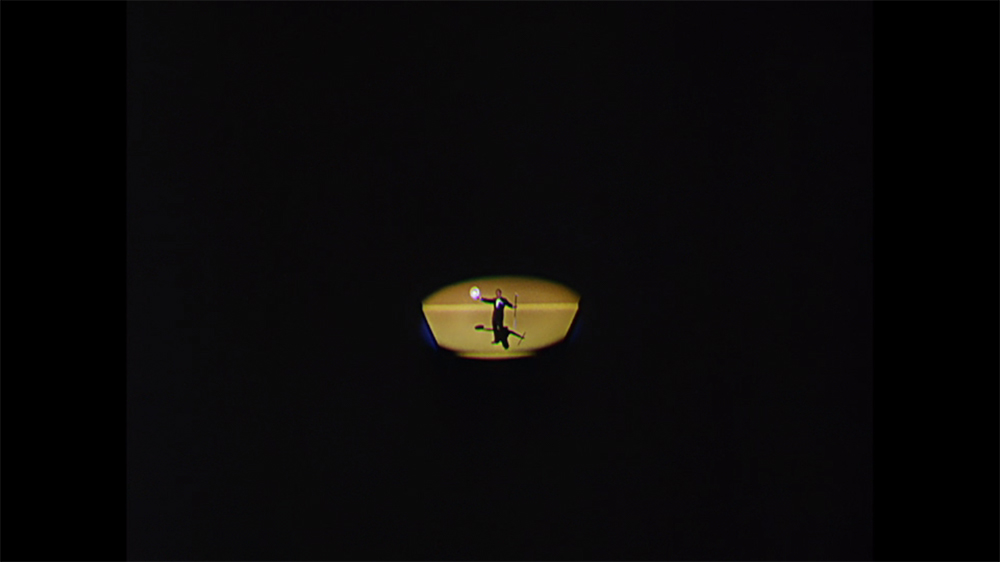
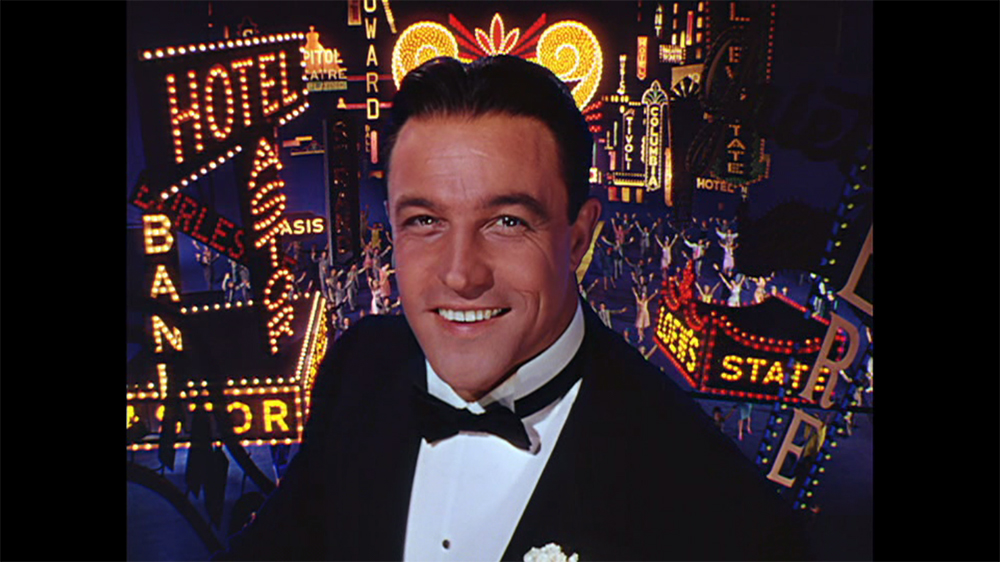
The setting of the internal film also corresponds directly to the inter-text with a parallel urban setting. Despite this similarity, there are many differences between the settings that reflect the changes that have accrued in the cinematic medium and its language. The most striking difference is the colorfulness of the set that consists of lights. Donen and Kelly demonstrate in a tangible way the statement of the song saying "A million lights – they flicker there.” The use of cinematic language and its technical possibilities are part of Donen and Kelly's wrestle with Beaumont, The Broadway Melody's director. They present themselves as artists who fulfill the artistic vision of their artistic father, using technical advances that did not exist in his time (the use of color), as well as cinematic language (different points-of-view), not yet formulated in his days.
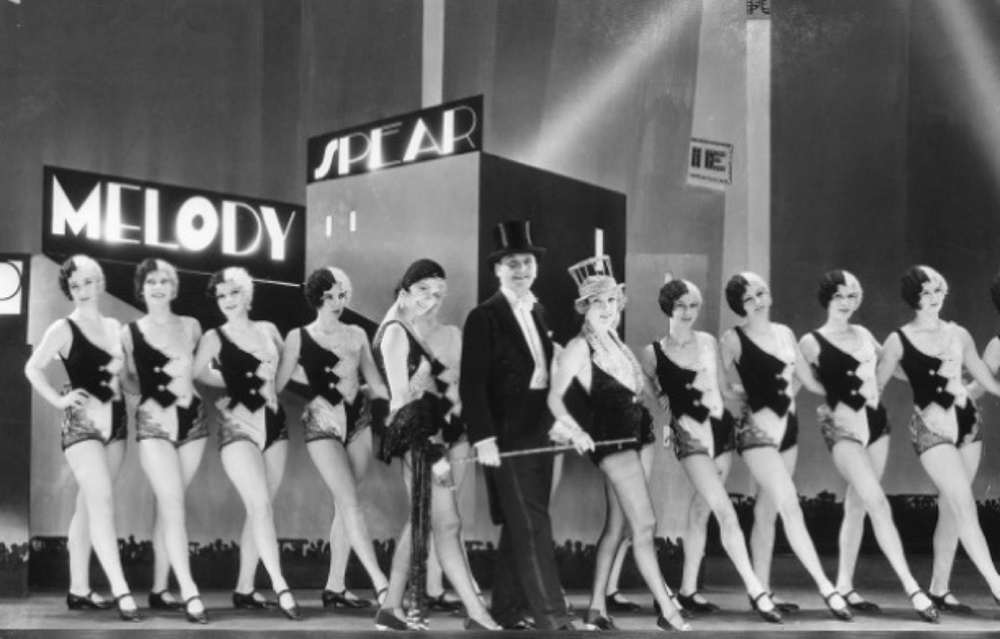
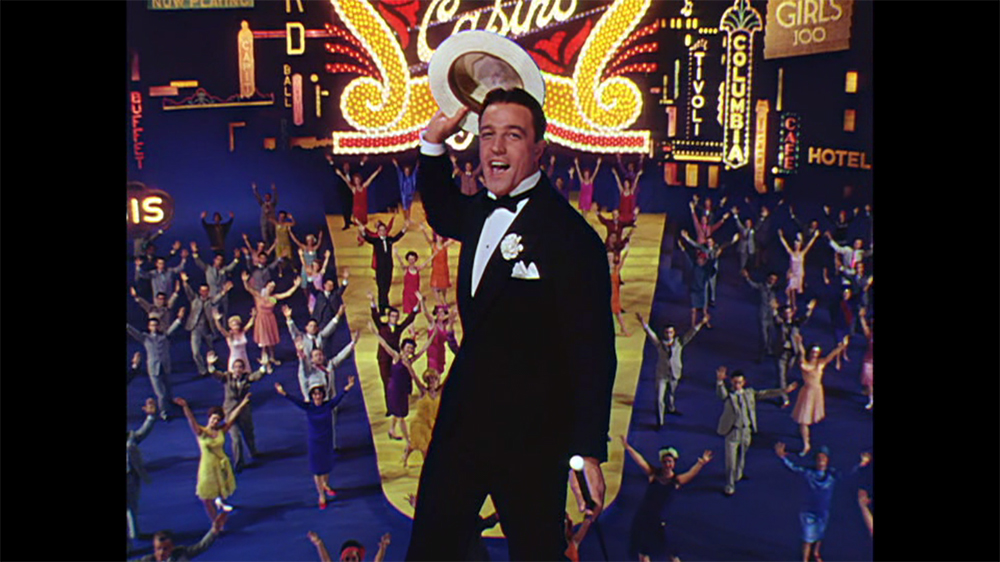
In the second part of their “misreading,” Donen and Kelly present a deep observation into the protagonist's inner life. They create the impression that they understand the mental life of the main character better than Beaumont, the director of the inter-text, and give it a wider artistic expression. Their creation is a “misreading” that seeks to revitalize the inter-text that inspired them and to lead the text to artistic greatness that its creator, their artistic father, did not reach.
The second inter-text that Donen and Kelly “misread” is the German film Der blaue Engel. The intertextual dialog, in this case, is not just a dialog between creators and texts, but also an intercultural dialog between the American cinema as opposed to German cinema, between Hollywood’s film industry, based on commercial interests and well-known stars, versus what was considered the height of cinema culture: German Expressionism, and classic German cinema.
The film Der blaue Engel tracks the deterioration and destruction of Immanuel Rath (Emil Jannings), a demanding teacher who falls in love with Lola-Lola (Marlene Dietrich), a cabaret prostitute. To this day, this film is identified with the iconic figure of Marlene Dietrich. Subsequently, the interface between the film Der blaue Engel (inter-text) and the internal film Broadway Melody (main text) is the character of the seductive woman, portrayed by Cyd Charisse. Both capture the protagonist and break his heart.
At the same time, the internal film Broadway Melody is distinct from Der blaue Engel in several major themes. For example, even though the film Der blaue Engel is considered groundbreaking and innovative in the way it combined sound and image, and defined the uniqueness of talking films as an audiovisual medium (Preminger, 1996), Donen and Kelly's “misreading” of this movie is done without words. The choice to direct this part of the film without words deepens the identity of the demonic and seductive woman to the primordial pre-culture sexual urge, existing since the dawn of time, before the invention of language. In fact, it can be said that the choice to direct this chapter without sound, despite von Sternberg's audiovisual innovates, is part of Donen and Kelly's wrestle with their artistic father; they supposedly understand his intents better, and express the identity between the seductive woman and the human libido fully and more coherently.
The meeting between the protagonist and the seductive woman happens in both cases when the man enters a night club. In the film Der blaue Engel, Rath comes to Lola-Lola's club in order to scold her for disrupting his pupils' education and falls in love with her. He loses his hat, and leaves the club with panties that Lola-Lola tossed over his face. This illustrates visually the internal process that Rath goes through during the film when he leaves the trappings of bourgeois life to follow his urges (Ibid).
Similarly, Kelly's character meets Charisse at a nightclub when he stops in front of a hat placed on her foot, parallel to Rath's lost hat. The first association that arises is that the hat belonged to her former victim, someone of likes of Rath, who lost his mind after falling in her net. The fear that is generated is that, like Rath, Kelly is doomed to be her next victim; an assumption that becomes well established when Kelly takes the hat from her foot and places it on his head.
Donen and Kelly's “misreading” of Der blaue Engel generate an additional meaning to Rath's hat: it is not just a sign of the bourgeois class, but an object of temptation when Charisse raises her leg with the hat on her foot, fixing on Kelly's gaze. This seductive movement echoes the character of Lola-Lola, and the image associated with Der blaue Engel, in which Dietrich’s leg is slightly bent. When Charisse lifts her leg, she expresses her sexuality prominently and more blatantly than Dietrich’s Lola-Lola. Charisse's blunt sexuality is supported by the camera’s point-of-view, gazing at her with a slow close-up that did not exist in the original inter-text.
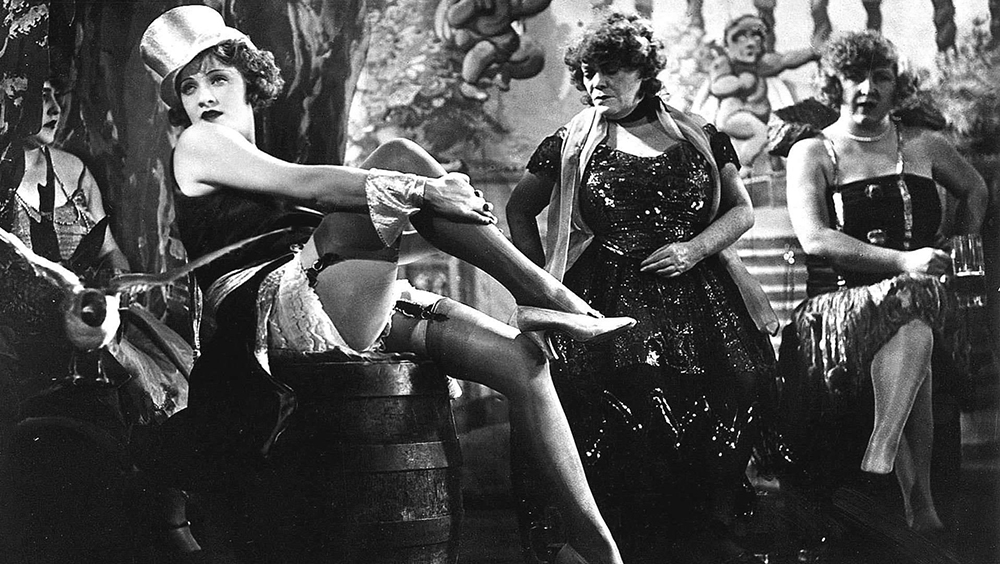

When Charisse gets up from her seat and begins to dance, Kelly's character follows her and responds to her. This scene is contrary to the previous scene, when Kelly danced alone freely. He loses his freedom and becomes captivates by his temptress. She tosses his glasses away, takes off the hat, and blows smoke in his face. Charisse strips Kelly of his bourgeois characteristics (the glasses and the hat), as Lola-Lola did to Rath, and blows smoke at his face, parallel to Lola-Lola, who tossed her panties at Rath's face.
This parallel between the cigarette smoke and Lola-Lola's panties marks the smoke as representative of dark sexuality. Accordingly, when Kelly inhales the smoke he breaks free from his cultural chains, and connects with his impulses. He is not led by Charisse, but responds to her, and their dance becomes a powerful and sensual dialog. Donen and Kelly create the impression that, contrary to Der blaue Engel, in which the relationship between Rath and Lola-Lola were one-sided and based primarily on desire and fantasy, in this case, there is a connection between two people who communicate with each other using body language, and more specifically, through a dance that expresses their sexuality.
Their relationship ends when Charisse is dazzled by a diamond bracelet and follows her mobster/gangster boyfriend. Unlike Rath, who lost his mind after seeing Lola-Lola with another man, Kelly's character does not sink into sadness. He continues with his plan to become a Broadway success and eventually fulfills his dream. He meets Charisse again at a high society ball, and his heart goes out to her. The film goes deeper into his consciousness and portrays a ballet fantasy in which he unites with Charisse. The choice of a ballet stands in stark contrast to their previous passionate dance, highlighting the fact that, for Kelly, this is not a matter of lust but love. This deepening into the consciousness of the protagonist does not exist in Der blaue Engel. It is yet another expression of the wrestling between Donen and Kelly with von Sternberg and an expression of the importance of dancing for the protagonist. After daydreaming, Kelly approaches Charisse, but she dismisses him and goes off with her mobster/gangster boyfriend. He leaves the ball sad and hearted-broken, but his vitality arises when he meets a young man striving for success, just as he was at the beginning. Kelly returns to his dance, his art, and ends the internal film with the musical sentence: “It's a Broadway Melody” surrounded by a spectacle of colorful lights.
As opposed to Rath, who dies at the end of the film Der blaue Engel, Kelly's character finds within himself vitality and artistic drive. The choice to end the internal film with a Broadway celebration is a song of praise to the American culture and its liveliness. While Rath symbolizes the decadence of the German bourgeoisie, and Lola-Lola symbolizes the empty straying after one’s sexual drive, Kelly's character is driven by creativity and vitality, which are, subsequently, the Broadway Melody.
Donen and Kelly chose to “misread” Der blaue Engel and to lead it to artistic greatness that von Sternberg, their artistic father, did not reach. Furthermore, they chose to “misread” von Sternberg’s artistic achievements. The film Der blaue Engel is known, among other things, for the iconic image of the seductive woman, and diving into the protagonist’s emotional life. Following that, Donen and Kelly “misread” the character of the seductive woman, making her primordial and inclinational even more that the female character in the inter-text and diving into the consciousness of the protagonist, creating a better understanding of his inner life.
However, the “misreading” in this case is not only a matter of artistic struggle; it is not just a case of “wrestling with the greatest” but also a cultural battle. The vibrant image of Kelly, representing American culture, is opposed to the degenerate and empty character of Rath, representing German bourgeois culture. The heartbreak they experience following the abandonment of their beloved causes both of them to withdraw into themselves, but as Rath fades into the void in his soul, Kelly finds forces of vitality and creativity within himself. In contrast to the loneliness and death at the end of Der blaue Engel, when Rath dies alone at his old desk, the internal film Broadway Melody ends with a celebration of life, when Kelly sings “The Broadway Melody” accompanied by dozens of dancers and colorful lights.
It can be said that Donen and Kelly remove themselves from the shadow of their artistic father when they “misread” his work, and from the shadow of what is considered high culture. They crown the popular American culture as representative of true art, stemming from a desire for creativity and liveliness.
Conclusions
The film Singin' in the Rain focuses on the transition from silent to talking films, demonstrating how the technical development of a sound system created possibilities that gave rise to a new cinematic genre and required the invention of a new language. Cinema is an evolving art; however, changes in the dramatic structure do not occur at the same pace as the industry’s technological development (Preminger, 1995). It appears that, nowadays, as the cinematic medium undergoes substantial technological advances (such as 3D film theaters and computer animation), the coming of sound and its resulting impact can offer a new perspective on the changes occurring today, both technically and artistically.
The film Singin' in the Rain deals with the cinematic language and cinematic medium, addressing the idea of language invention, namely the language of talking films. Creating a language, according to Bloom’s theory, is every artist's dream, fulfilling the artist’s aspiration of originality and innovation. This movie, however, was made two decades after the transition to talking films, and its creators can only regret their late birth (to use the Bloomian phrase), after the new cinematic language was already codified. The solution presented here is to create a film about the invention of a language and to address the nature of the cinematic language while “misreading” canonical inter-texts.
The inter-texts, one an American musical (The Broadway Melody) and one an innovative German film (Der blaue Engel), present two different cinematic languages that have both shaped the language of talking films. By “misreading” these inter-texts, Donen and Kelly refer not only to the development of media but also to the critical discourse of that time. During the 1920's, German directors were considered artists, and German films had an enormous presence in the critical and artistic discourse (Allen and Gomery, 1985). The film Singin' in the Rain looks back on the 1920s not only in a cinematic sense, but in an academic sense, when it relates to the discussion about American popular films and German artistic films. It objects to the existing perception of that time, claiming indirectly that, as opposed to popular opinion, true art is represented not by German films but rather by entertaining American musicals.
The film Singin' in the Rain tries to raise awareness within its audience, while remaining an entertaining musical, accessible to different audiences. As such, it seems as though Donen and Kelly, who argue that the American musical is a true form of art, are able to create a movie that fulfills their goal: an enjoyable musical that, at the same time, enfolds profound insights regarding the very essence of the cinematic language and medium.
Works Cited
Arthur Freed. (Producer), & Stanley Donen and Gene Kelly (Directors). (1952).
Singin' in the Rain. USA: Metro-Goldwin-Mayer. Film
Ben-Porat, Ziva. Intertextuality. In: Ha-Sifrut, 2/34.1985. 170-178 [Hebrew].
Riffaterre, Michael. Semiotics of Poetry. Bloomington: Indiana UP. 1978. Print.
Bloom, Harold. The Anxiety of Influence: A Theory of Poetry. London: Oxford UP. 1973. Print.
Bloom, Harold. A Map of Misreading. London: Oxford UP. 1975. Print.
Thalberg, Irving and Weingarten, Lawrence. (Producers), & Beaumont, Harry (Director) (1929). The Broadway Melody. USA: Metro-Goldwin-Mayer. Film. Erich Pommer, (Producer), & Joseph Von Stemberg (Director). (1930). Der blaue Engel. Germany: Universum Film A.G. Film.
Preminger, Aner. Literature, Movies and Prejudices.1996 http://www.education.gov.il/tochniyot_limudim/sifrut/asi16004.htm [Hebrew]
Preminger, Aner. Enchanted Screen: A Chronology of Media and Language. Tel Aviv: The Open University of Israel Press [Hebrew]. 1995. Print.
Allen, Robert Clyde and Gomery, Douglas. Film History: Theory and Practice. New York: Knopf. 1985. Print.